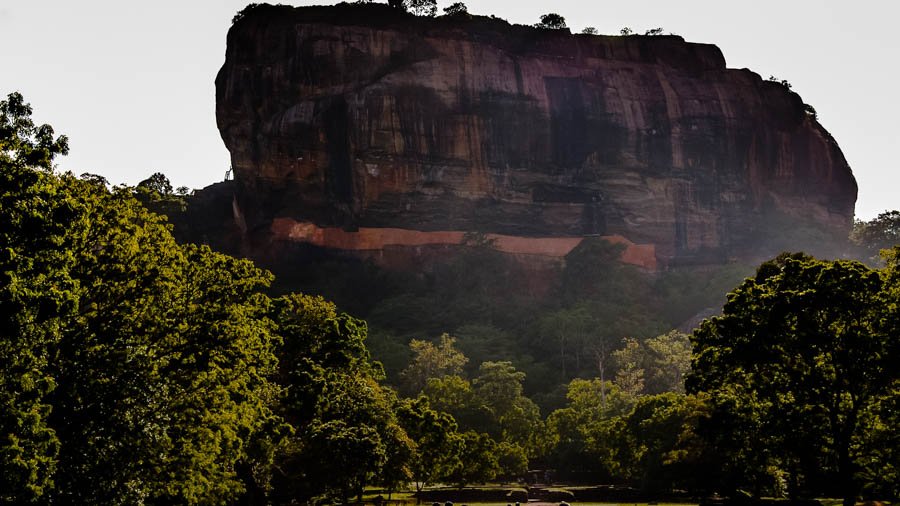Sigiriya Lion Rock rises 360 meters above sea level. While it is not a Buddhist pilgrimage site, it is very important historically and archaeologically and is one of the UNESCO Cultural Triangle sites. As described later in this post, it was also home during separate periods of hundreds of years to Buddhist monastic orders
The Winter Palace
The Winter Palace at the very top rises another 200 meters from the water gardens at the base of the rock. As usual, when we arrived, Aslam introduced us to another excellent guide, who’s name was Ruwa.
Ruwa explained in picturesque language how the first king of Sigiriya came to built his kingdom here in 477 AD. His name was Kasyapa I. Being the illegitimate son of King Dhatusena I (459-477 AD) by a non-royal consort, Dhatusena had no plans to make him heir to the throne or any kingdom, for that matter. According to Ruwa, one day his father brought Prince Kasyapa to a pool on the palace grounds to tell him what was coming to him. He took a handful of water and threw it up into the air and said, “This is what is yours.” Kasyapa killed him on the spot and fled to Sigiriya to build his kingdom.
In truth, Dhatusena was a despicable character and had many enemies, so Kasyapa had help in dispatching him. His brother, Mugalan, however, who had a legitimate claim to the throne fled to India at the time but eventually came and battled Kasyapa, who committed suicide when it was clear he had lost an important battle. He was the only king who ever ruled Sigiriya.

Sigiriya is one of Asia’s major archaeological sites, with a history extending from prehistoric times to the 18th century. We walked through urban ruins, including architecture, gardens, art, and hydraulic technology dating back to the 5th century AD when Kasyapa arrived.
Historically, Sigiriya goes back much farther in time, to the 3rd century BC when a Buddhist monastic settlement was established in the area, evidenced by 30 rock shelters dated by inscriptions on the rock face, recording the granting of these caves by the crown to the Buddhist monastic order to be used as residences. Then again, for hundreds of years after the Kasyapan empire ended, Buddhist monastics again settled into the area until about the 13th or 14th century.

Mirror Wall
Just below these is the Mirror Wall, full of very ancient graffiti. Some of it is so old that the language is no longer decipherable and has no relationship to modern day Sinhalese. The aspara paintings brought pilgrims from all over the world, many of whom left messages and poems to the ladies on this wall. One example cited in The Cultural Triangle of Sri Lanka, published in 1993, is this touching ditty,

"I am Lord Sangapala I wrote this song We spoke But they did not answer Those ladies of the Mountain They did not give us The twitch of an eye-lid"
Aspara Cave Paintings
H.C.P. Bell, the British archaeologist who studied the paintings from 1894 onwards, describes them as portrayals of the ladies of Kasyapa’s court. Senerath Paranavitana suggested that they represent Lightning Princesses and Cloud Damsels in an attempt to identify Sigiriya as a representation of divine kingship, an interesting theory considering Kasyapa’s history. The third hypothesis belongs to Ananda Coomaraswamy, who identifies the women as asparas or celestial nymphs.
The top was spectacular for the views it afforded, where you can see Polonnaruwa and Anuradhapura off in the distances. The palace was terraced with the very top housing the main hall going down to the pool, then the kitchens and finally the dance hall at the very bottom.


2 thoughts on “Sigiriya Lion Rock, Sri Lanka”
Thanks for your site! I am linking you on buddhistartnews.com!
Jon C.
We have just returned from Sri Lanka – thanks for the wonderful memories of he amazing Sigirya – great photos to capture its true beauty.
Comments are closed.